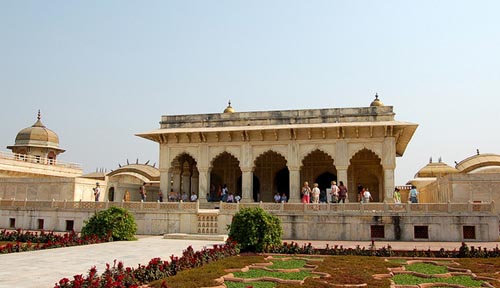Khas Mahal

Information on Khas Mahal (Red Fort, New Delhi) - History & Architecture
The Khas Mahal was used as a personal abode of the Mughal emperors in Delhi. This monument is situated inside the premises of a huge compound within the city area, Red Fort. This structure was constructed by the great Mughal emperor, Shah Jahan between the period of 1631 to 1640. The Khas Mahal is also alternatively known as Aramgah-i-Muqaddar. A river runs on one side of the structure and on the other side lies another structure that is the Anguri Bagh. The Khas Mahal was believed to be built specially for Shah Jahan's two beloved daughters Roshanara and Jahanara. It is supposed that Jahanara resided on the northern one among the two nearly alike pavilions. The two pavilions or alcoves were split from the main hall area with the help of a tall marble wall.
Khas Mahal Architecture
The Khas Mahal comprises three different sections and they are the Chamber of Telling Beads or Tashib-Khana, the Sitting Room, Baithak or the Wardrobe, Tosha-Khana along with the Sleeping Chamber or Khwabgah. The Tashib-Khana or the Chamber for Telling Beads was made use of by the king for the purpose of personal worship. The Sleeping Chamber or the Khwabgah was used for the purpose of sleeping or in other words it can be stated that it served as a bedroom. An elongated hall is situated on the southern side of the Sleeping Chamber with well decorated ceiling and walls. The hall consists of a penetrated screen on its western side and is either known as Baithak, Sitting Room or the Tosh-Khana, Robe Chamber. The internal portion of the structure is beautifully painted with floral motifs and is carved with marbles in white colour. The ceiling was also known to be partly covered with gold. A magnificent marble made screen at the northern most end of the rooms can be witnessed which has a 'Scale of Justice' engraved and hanged over a semi-circular encircled with clouds as well as stars. The 'Scale of Justice' was used as a form of representation of the ruler's impartiality. A specific significant piece of Mughal art can be spotted just above the 'Scale of Justice'.
The extending tower on the eastern side of the structure is referred as the Octagonal Tower or Muthammam Burj. The emperor was known to speak to his citizens each morning through a formal procedure called Jharokha Darshan.
Khas Mahal History
The Khas Mahal is a beautiful structure designed according to the typical Mughal architectural pattern. The structure stands a symbol of Shah Jahan's fatherly love for his two preferred daughters Roshanara and Jahanara. The Khas Mahal has a striking tank which faces the fountains, open courtyards and pavilions made of white marbles. The ceilings of the palace or the structure are known to be richly decorated and the compound features elegantly engraved as well as sculpted brackets. The apertures found on the walls were previously known to hold paintings of the Mughal emperors and the iron made loops on the ceiling of the main hall were particularly used for holding chandeliers. The pavilions of the palace are made of red coloured sand stone with plastering of white shell and have intricate work of gold in the wall paintings. The interiors of the structure easily catch the attention and fancy of the visitors owing to the brilliant carvings and also for the usage of royal colours such as blue and gold. It has been derived from an inscription on a particular part of the structure that the construction commenced from the year 1639 and ended in 1648 and involved an expense of fifty lakh rupees.
Khas Mahal Tourism Significance
The Khas Mahal attracts a lot of visitors owing to the fact that it is housed in the premises of the Red Fort. Therefore, the Khas Mahal forms a part of the itinerary of the people visiting the Red Fort.
- Andaman Nicobar Monuments
- Andhra Pradesh Monuments
- Assam Monuments
- Bihar Monuments
- Chhattisgarh Monuments
- New Delhi Monuments
- Goa Monuments
- Gujarat Monuments
- Haryana Monuments
- Himachal Pradesh Monuments
- Jammu and Kashmir Monuments
- Karnataka Monuments
- Kerala Monuments
- Madhya Pradesh Monuments
- Maharashtra Monuments
- Odisha Monuments
- Punjab Monuments
- Rajasthan Monuments
- Tamil Nadu Monuments
- Telangana Monuments
- Uttar Pradesh Monuments
- West Bengal Monuments